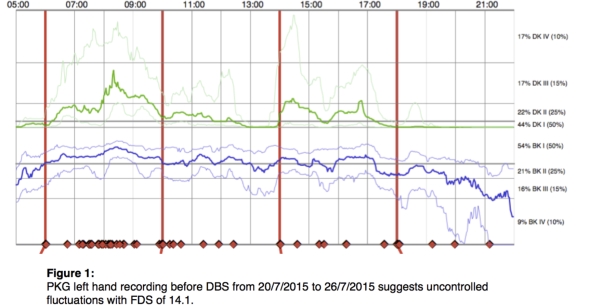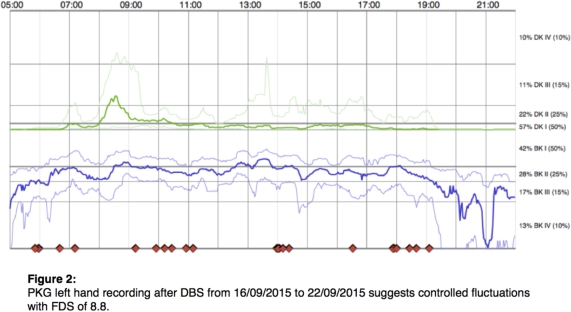Session Information
Date: Tuesday, June 21, 2016
Session Title: Technology
Session Time: 12:30pm-2:00pm
Location: Exhibit Hall located in Hall B, Level 2
Objective: Case study: objective recording of motor fluctuations and dyskinesia in PD patient before and after STN-DBS by using continuous accelerometry system and automated computer algorithm for the assessment of bradykinesia and dyskinesia.
Background: Medicament treatment of patients with advanced stage PD is difficult due to variability of the state of patient’s flexibility. In these patients motor fluctuations and dyskinesias are observed which until now have been routinely assessed by anamnestic data or patient’s logs of mobility. The reliability of the latter is questionable since the logs depend on patients’ or caregivers’ subjective interpretation of motor states and willingness to record them. Accelerometers with algorithms for automatic assessment of bradykinesia and dyskinesia enable an objectivization of the patient’s mobility in routine practice. Such system was tested in the assessment of treatment success with bilateral STN-DBS in patients with advanced PD.
Methods: To assess the state of mobility we used the Parkinson’s KinetiGraph (Global Kinetics Corporation). An accelerometer in a form of a bracelet was placed on the patient’s right wrist for 6 days of continuous movement recording. First recording was performed before bilateral STN-DBS surgery (Figure 1) and the second recording took place two weeks after the stimulator was switched on (Figure 2).
Results: Great variability was observed in the timing, duration, severity of dyskinesia symptoms from day-to-day (Figure 1) before STN-DBS surgery. Dyskinesia persisted for several hours during the day and overall mobility was good, with evidence of wearing off prior to the 18:00 dose. Fluctuation Dyskinesia Score (FDS) showed marked improvement after surgery (Figure 2). Patients FDS was 14.1 before (uncontrolled fluctuations) and 8.8 after (controlled fluctuations) the surgery. The patient was taking levodopa/carbidopa/entacapone (100/25/200) qds. 

Conclusions: The use of new portable accelerometer can objectify the patient’s fluctuations and dyskinesias and evaluate the success of therapeutic measures. Due to its simplicity this method could serve in the future to simplify and objectively evaluate the progression of the disease and the appropriateness for advanced forms of treatment such as DBS. Adoption of such tools in clinical trials could replace the current unreliable subjective mobility evaluation logs.
To cite this abstract in AMA style:
D. Flisar, B. Pikš, B. Meglic, Z. Pirtošek, G. Kramberger. Objective movement recording in PD patient before and after STN-DBS [abstract]. Mov Disord. 2016; 31 (suppl 2). https://www.mdsabstracts.org/abstract/objective-movement-recording-in-pd-patient-before-and-after-stn-dbs/. Accessed January 5, 2026.« Back to 2016 International Congress
MDS Abstracts - https://www.mdsabstracts.org/abstract/objective-movement-recording-in-pd-patient-before-and-after-stn-dbs/
